The Wrong Direction: The Storytelling of Fahrenheit
By gamer_152 15 Comments
Note: The following article contains major spoilers for Fahrenheit.
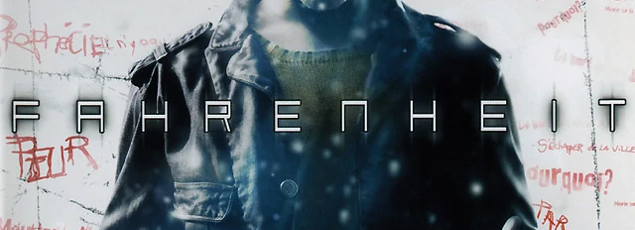
"MAN: Okay, how many of you kids would like Itchy & Scratchy to deal with real-life problems, like the ones you face every day?
KIDS: [Cheer and agree]
MAN: And who would like to see them do just the opposite - getting into far-out situations involving robots and magic powers?
KIDS: [More cheering]
MAN: So, you want a realistic, down-to-earth show... That's completely off-the-wall and swarming with magic robots?
KIDS: [Agree]
MILHOUSE: And also, you should win things by watching".
-The Simpsons, S8E14: The Itchy & Scratchy & Poochie Show
I wonder if David Cage is one of those figures we'll look back at in ten years time and feel embarrassed to have taken seriously. The president, writer, and director at Quantic Dream, David Cage has been trying to make games that look and act more like films for the better part of two decades and has been vocal in his belief that his form of expression will elevate games as a storytelling and artistic medium. His works such as Beyond: Two Souls and Detroit: Become Human feature everyday people suddenly enduring extraordinary suffering. Their highly tactile control design lets the player feel their way through every moment of the protagonists' days from opening their front door to brushing their teeth. Cage is also an unusually public-facing director, styling himself as an auteur figure through which the emotional sap of the medium will be tapped. No shortage of column space has been dedicated to the director's interviews and speeches, his media reviews favourably, and he commands one of the largest followings for narrative-driven games there is. Yet, the exact audience Cage is trying to woo are tired with and underwhelmed by his work.
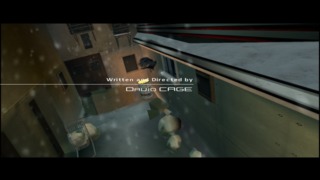
The commentators who are concerned with the advancement of games as a means for empathising and self-expression have often derided these experiences for being emotionally ham-fisted and having an extraterrestrial understanding of human communication. There is particular scepticism towards his evangelising around motion capture and high polygon counts. For many, Cage became the embodiment of the superficial visionary; in every development cycle, promising a magnum opus but delivering a bargain bin flick. He's also been called out for his less than understanding treatment of his female characters, and in the case of Detroit: Become Human, for trivialising aspects of the civil rights struggle.
If Cage's transgressions stopped there, he might be an ultimately harmless man who'd just spun a few disappointing yarns, but the controversy goes leagues beyond the quality of his art. In January 2018, three French publications reported that Quantic Dream employees alleged that the studio overworked them, let degrading images of them circulate on internal networks, and was rife with discrimination. But it was Cage's responses that were the nails in the coffin. He not only dismissed his workers' concerns publicly but then showed a profound ignorance of how discrimination functions. He attempted to refute critics by saying that he worked with Ellen Page and Jesse Williams, two minority activists. It was a big-budget remake of the "I have a black friend" counterpoint. He then took a hatchet to the journalistic sphere by suing outlets who reported on the case. A French court eventually upheld the accusations of toxic workplace culture.
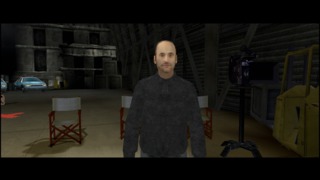
The best thing we could say about Cage and his work is that while he's acted immorally as a human being, his creations provide a rare splash of pioneering humanity. That his games, while imperfect, are moving and have significantly advanced the medium's ability to present relatable characters and stories. It's conceivable that without Fahrenheit and Heavy Rain, later cinematically-minded games like Uncharted and The Her Story would never have existed, and those are widely regarded as some of the best work in the medium. The worst thing that we could say is that he's a hack writer who has been able to constantly fail upwards because of his luck in marketing himself as a genius director and because of the game industry's bias towards tech over creative talent. He has notions of filmic aspiration unaccompanied by the human understanding and artistic mastery that has made the cinema he admires so worthy of acclaim, and his workplace management is an extension of the lack of empathy that shows in his writing. I mention the rash of workplace toxicity not because I think Cage being abusive is proof that his games are bad, but because I want to make it clear that I'm not excusing Cage of that conduct when I write about him. Whatever gripping aspects he may have peppered his storytelling with, no amount of skilful software development gives you a ticket to make the industry a worse place to work in and report on.
The title we're going to discuss here is the one in which Cage first codified his trademark design style. In 2005, Quantic Dream released a game written and directed by him which went by "Fahrenheit" in most territories but was dubbed "Indigo Prophecy" in North America. Quantic made this choice so that the U.S. public wouldn't confuse their game with Fahrenheit 9/11: the Michael Moore documentary released the previous year. In 2015, the work was remastered and re-released by Aspyr Media Inc. under the name Fahrenheit: Indigo Prophecy Remastered, likely because Aspyr needed to account for launching the game worldwide to people who knew it under different banners.

Fahrenheit was not the first project under Quantic Dream's belt, that would be the 1999 sci-fi The Nomad Soul, but where The Nomad Soul is a typical adventure, Fahrenheit is, like subsequent Cage properties, bordering on an interactive film. It mostly forgoes conventional action and puzzle mechanics for the liberally-applied quick-time events and extended narrative sections which would become Cage's calling cards. And while Cage situated The Nomad Soul in a science fiction future, Fahrenheit represents his shift to working in a simulacrum of the real world, which he would continue to do in Heavy Rain and Beyond: Two Souls. Cage said of working on the project:
"I learned an enormous amount from it and it profoundly changed my vision of interactivity. I won't make video games the same way [...] after Indigo Prophecy [...] In my personal development it constitutes an important stage toward making video games not just simple toys but a veritable form of expression".
Ergo, to understand later Cage games, and even to understand later games that included branching narrative paths and put story before mechanics, we have to read Fahrenheit. The first thing Fahrenheit wants you to know is that you should treat it as a film with Cage as the would-be Spielberg at its helm. The main menu doesn't say "New Game", it says "New Movie", and the pause screen doesn't say "Resume" and "Quit", it says "Play" and "Stop". The tutorial has us meeting Cage and him directing us on a film set. A mid-story scene features a Citizen Kane poster but with Cage photoshopped into it. One of the fictional news articles in this world reports that the director's debut title, The Nomad Soul, is being adapted into a film trilogy that is expected to win multiple Oscars. These aspects are grossly indulgent of the writer and director, but fortunately, stay off to the side for most of the playtime.
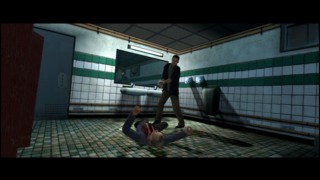
As we move into the introduction proper, we get some narration from everyman I.T. technician Lucas Kane. He describes himself to us a "pawn" and says that everything about the world we believe in, from its history books to the television is an illusion, and that we generally reach a time when we have to wake up from this dream. In a freezing New York borough, he sits in the bathroom stall of a cheap diner, lost in a religious trance. He has carved a two-headed snake into his arms and kills a stranger with a ritualistic stabbing that cuts his heart off from the rest of his body. During the assault, Kane has visions of a man in robes and a mysterious little girl. He snaps back to reality, horrified at the gore in front of him and flees the scene. He describes his mental state during the murder as though he were possessed and over the following days experiences extreme stress and apparent hallucinations, including witnessing alien insects infesting his workplace and finding crows nesting in the nooks and crannies of his home of New York. He also develops preternatural strength and speed, and the abilities to read minds and predict the future.
Hot on Kane's heels are NYPD detectives Carla Valenti and Tyler Miles. Valenti is an old face on the force with a sensible demeanour and infinite reserves of energy, while Miles has only been with the department for a year, and doesn't take himself as seriously. At the restaurant, they find scant clues and a foul-mouthed homeless man, but little else, and over the course of the game must gradually bring the nature of Kane's crime into focus. Miles does this while knowing that he's straining his relationship with his girlfriend Sam who feels neglected and fears for Miles's life given his line of work. Meanwhile, Kane's mind unravels as he tries to discover the nature of his affliction and has increasingly close brushes with the law.
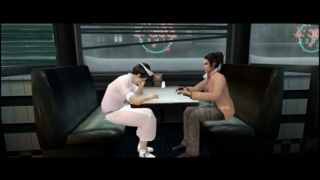
When you see people who played Fahrenheit reminiscing about it, the opening scenes in the diner are always called out as a high point. A boilerplate piece of advice for newbie writers is that they have to grab their audience in the first few lines of the script or novel, giving readers a reason to invest in the protagonist and care about what happens to them, but video games usually open their curtains on tiresome tutorials, toothless training areas, or utilitarian exposition dumps. Fahrenheit immediately gives you a reason to sympathise with its protagonist: he's at risk of being accused of a murder he didn't commit, and encouragement to become invested in the scene: someone could walk in and pin the stabbing on him at any second.
Then, when you re-enter the diner as Carla and Tyler, you can see your attempts to cover up your crime as Lucas defining the evidence the detectives have to work off of. You have to remember, at the time this came out, reactive narrative games were a twinkle in the medium's eye; Telltale was barely off the ground. Whatever else we might say about Fahrenheit going forwards, these scenes in the diner are, taken alone, revolutionary. And much of the following game kickstarts what will eventually become the interactive story genre. The bad news is that 99% of Fahrenheit is not as malleable as the diner scene. Its systems generally offer many choices of objects to interact with and dialogue options to pursue, but few of those interactions and objects change the makeup of future scenes.
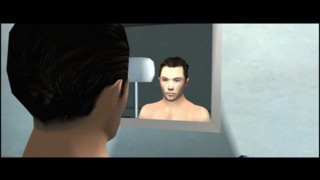
There is, however, an original and fascinating setup for a murder mystery here. Often, the format relies on the audience not knowing who the killer is, what their motive was, and/or their exact mode of attack. We stay engaged by following the breadcrumb trail of the case through the eyes of its investigators. Fahrenheit is subversive in that we know who committed the murder, we know their method, and we know that their motivation wasn't part of the equation as they had no control over their actions. Despite this, there's still a whole enigma to be solved. Unfortunately, in deconstructing that mystery, our efforts often serve to be self-defeating, and the diner interactions are a perfect example.
When playing games, we generally need a sense that our choices can lead to the forward progress of the characters under our watch; otherwise, our successes don't mean anything narratively. In Fahrenheit, we take on the roles of the killer and the characters trying to lock the killer up, so every time we play Lucas and put a little more distance between us and the police, we subsequently lose that ground when we take control of Tyler and Carla and edge them closer to the truth. We then switch back to Lucas who we only use to jeopardise the investigation we're making with Carla and Tyler. As a conventional game, Fahrenheit is contingent on our victories, but in every scene, a part of me wished that I'd fall short of expectations so that I wouldn't make future challenges any harder than they had to be, and it's impossible to root for all our protagonists when their goals are diametric. The absurd culmination of this tug of war with ourselves is a duologue in which Tyler or Carla interviews our panicky I.T. tech and can discover he's the killer, but if they do, it qualifies as a "Game Over". When our opponent is ourselves, even the win state becomes a loss state.
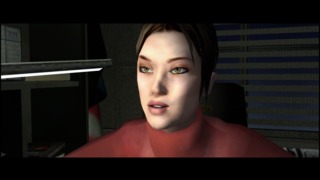
The self-sabotaging consequences for our progress are part of an all-encompassing fault in Fahrenheit where Quantic has a fresh and well-defined vision for the game, but never quite takes into account the bit where the player will interface with it. Take, for example, the control scheme. We interact with people and objects by flicking the right control stick (or our mouse) in a designated direction. This means that when you want your character to pull a door open, you pull back on the stick, mimicking their action, or when you want them to get out of bed, you flick the stick upwards, giving a "rising" feeling. But sometimes the movement you make on the controller has nothing to do with the motions of your character. There's a setup in which you can pull one of two drawers out of a cabinet, both of which open in the same direction, but one of which you access by swiping right on the stick and one of which you access by swiping left. Or whenever there's a choice of speech prompts, we use directional stick inputs to pick them. In what way does jerking the right stick down mimic asking someone about crime scene evidence?
The developers show a similar lack of understanding of how to make quick-time events confluent with character behaviour. Here's a basic standard for game design: When the protagonist is doing something physical, you prescribe the player hand-eye coordination tasks, and when they're doing something mental, you task the player with puzzle or strategy play. Do this, and the user will feel a concordance between their actions and the actions of the main character. Fail to do this, and they will feel a dissonance. QTEs are a hand-eye coordination task, and Cage uses them to simulate physical activities like dancing and dodging flying debris, but he also uses them to embody psychological actions like inspecting a cadaver or remote viewing. There's nothing about hitting random directions on the arrow keys that feels like using telepathy. Similarly, the game has two prolonged sequences where it simulates us controlling our breathing by having us mash left and right on the bumpers, and it's such an uneasy clash. And for that matter, why does the game limit how many dialogue options we're allowed to use in any one conversation? Especially when we're playing the detectives, shouldn't we be able to question witnesses and suspects for more than a couple of minutes?
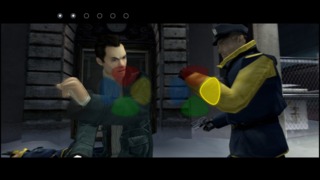
Even when Fahrenheit uses QTEs to have us play out a physical activity, it often doesn't match one input to one action, which is jarring. We might have to press three different buttons to punch a character in the face or to do a backflip, and so the illusion that we're in the protagonist's body is broken. We also can't turn a corner in this game without having to perform a series of QTEs. We might remember Fahrenheit as a game that trades out mechanically-driven scenes for filmic ones, but it's more that the game has just as much gameplay in it as any adventure title, it just makes that gameplay far more rudimentary and therefore more tiresome than other games. Interactive entertainment can thrive on a cornucopia of action scenes with well-developed gameplay or a smattering of action sequences fitted with more shallow gameplay, but you're not allowed to do what Fahrenheit does and have a lot of action scenes with shallow gameplay. You'd think that the monotony in the play is because Quantic couldn't develop more forms of interaction, but bizarrely, the engine has a first-person shooter system in it that the studio only uses once. One day Carla goes down to a gun range to test her hand, and the game appears to imply that this is training for us that we'll later use in the field, but it never comes up again.
Fahrenheit has one more feature system we haven't looked at yet, and it's the mental health meter. It will be familiar to anyone who's whipped out a pencil and paper to track their sanity stat in Call of Cthulhu. However, Quantic deploys the mechanic to explore stress and strain on the mind in a real-world context in addition to a fantastical one. Relaxing and hearing good news causes the meter to rise, while panic and disaster make it fall. I love this observation that being a homicide investigator is as much about managing the psychological wounds that the job inflicts as it is compiling and analysing evidence, and the meter gives you a reason to act like a regular human being, throwing back booze and taking to the gym in a pleasingly down-to-earth roleplay. The mental health variable also represents a shared burden that unites the detectives with Kane. While they might have different personalities and be working to fundamentally opposing goals, they have a shared emotional struggle. This system terraforms some common ground for them to stand on, which is important to lay down as Lucas and Carla will team up in the third act.
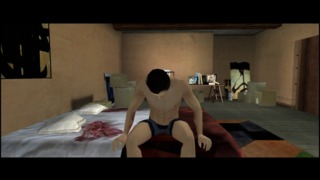
But this feature is contaminated by Fahrenheit's habit of taking promising concepts and implementing them thoughtlessly. Sometimes what raises and lowers your mental health doesn't work on predictable logic. You might expect that looking at a portrait of your loved ones would improve that score until you do it and find out they're no longer with the protagonist, and it causes the meter to dip. You might assume that Lucas seeing his apartment disintegrate and ending up hanging from his balcony would charge a hefty fee in mental wellbeing, but it doesn't cause the gauge to budge. Another issue is that the system has trouble modelling lasting trauma. The plot opens with Kane becoming wanted for murder, but have him chill out in his apartment the following morning, and he'll be back to a "neutral" mood in no time. Carla will learn that scattershot violence is a disease of her city, but any anxiety over it can be diluted by playing sports or fiddling with a yo-yo.
The meter never seems to determine characters' moods anyway. They can be mechanically "depressed" but in all narrative facets act and emote identically to when they're feeling fine. More broadly, the mental health bar constitutes a "tell, don't show" approach. If a character becomes anxious, instead of that anxiety registering on their face and in their words, the word "anxious" appears on screen in a far less elegant and less human solution. Why would a game trying to be more cinematic represent emotions through its UI instead of its actors? Cage explains:
"In the original script, everything was in place to make the player feel good or bad about his actions. In my mind, if the player decided to save a child by risking his own life, he would feel good about it. On the flipside, deciding to play it safe and [letting] the kid die would make him feel bad. I thought that these feelings would happen in the player's mind and that they would be obvious. When I could play the entire game for the first time, I felt that this idea was a little too abstract for the player. He would clearly need a visual representation of his mental health to make it more tangible for him".
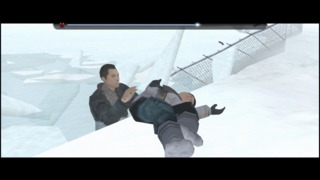
Let me summarise: David Cage didn't trust the player to feel sad when a child dies, and so he thought he needed to add text popups to tell us whether it was a good or a bad thing. If players aren't emotionally connecting with your work, then what they need is the content of that work to be more evocatively conveyed; they don't need an "Applause" sign. This decision is exemplary of how Fahrenheit thinks about presenting a story. I could forgive it for being so in-your-face about character feelings if the game emerged as the emotional sandbox it suggests it will, but it doesn't. Most of the prodigious boosts and catastrophic hits to the mental health stat are due to landmark plot points we can't avoid. This is almost certainly because the story was designed first, and the mental health reservoir added much later. And real psychological symptoms don't relate to each other the way they do in Fahrenheit. The game depicts depression and stress not as separate phenomena but as one simply being above the other on a totem pole of suffering.
Fahrenheit's mechanics pit ourselves against ourselves, can be exhausting to interact with, and offer a crude representation of what goes on in the human mind. However, they do flow from a highly forward-thinking philosophy for their time: these features are not there for the sake of empowerment but to let the player more vividly experience the story. Or at least, that's their intention. Fahrenheit has a garbled mechanical voice through which to describe the state of its characters, and that flaw extends into the storytelling.
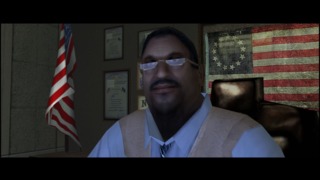
While the game's mechanics and its extended sequences of people in their homes may suggest that the experience cares about putting the mundane to code, a lot of it is sensationalised through a filter of generic detective drama. We have the older straight-laced cop and the rookie upstart, the scene where the police commissioner chews out his lackeys, and a streetwise black guy who loves disco and basketball. Having a story that feels true to the real-world is about more than having realistic subject matter; it's about preventing too many unlikely plot events, shunning clichés, and keeping speech natural.
As ever, it is not "objectively incorrect" if a creator decides that realism doesn't matter to their art or entertainment. However, the derivative nature of the police drama in Fahrenheit is to its detriment because it's played against the starkly real. What's more, because even the non-supernatural elements of the story test the audience's tolerance for the unbelievable, it fails to achieve Cage's goal of exploring the human. However, it's about to get far-fetched in the extreme. What I write next might look like a neurotically thorough retelling of Fahrenheit, and maybe it is that, but it's impossible to be brief when the game is reliant on so much plot dumping and complex lore. It's also essential to stop and smell the rotting roses if we want to identify where the game foreshadows its ending.
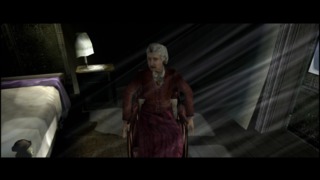
Picking up after the diner scene, Lucas dreams about the creepy girl he saw in his visions there and remembers an incident from his childhood. He grew up on a military base, and on one occasion at the camp, psychically predicted a fire before it started. Back in the present day, Lucas confesses his killing to his brother, a local priest called Markus Kane. Markus puts him in touch with a medium by the name of Agatha. Outside of Agatha's home, Lucas can spot a homeless man he recognises, and inside, he finds the house decorated with masks and cages full of crows. Agatha guides him through a ritual which lets him recall that a pale figure in a robe sat down and talked to him before he made his bloody attack in that bathroom. Lucas wakes from this trance convinced that Agatha knows who this man is, although she flatly denies it, and tells him to come back the following night. Because we need a name for him, I'll let you know now that the hooded man is called The Oracle.
As Lucas's plotline staggers forwards, Carla receives a tip-off to dig up the "Kirsten" case. She overcomes her claustrophobia to retrieve a file on it from the NYPD archives and then talks to a sergeant on the force about the investigation. Sgt. Mitchell describes a rash of murders during the 90s in which the killers cut snakes into their arms, separated their victims' hearts from their bodies, and then committed suicide. The method of killing is identical to Lucas's, save for the last step. Meanwhile, Tyler inspects a book that Lucas left at the crime scene and finds that someone with the initials "M.K." dedicated it to their brother. He also finds a scrap of paper inside that the reader was using as a bookmark. He faxes this to Carla. Carla's friend Tommy identifies that the piece of paper was torn from a page of stock listings and that the watermark on it will trace back to the bank that printed it.
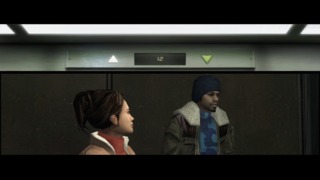
This leads Carla or Tyler to the Naser & Jones bank and its I.T. technician, Lucas Kane. They give him the once-over, and we can have them take incriminating evidence from Kane's office. This includes a pen smudged with his fingerprints and a photo of him with Markus. On Lucas's return visit to Agatha, he finds her murdered and that someone made a call to the police from her phone, summoning them to the house. He escapes. Based on what Carla and Tyler have deduced so far, and possibly also the items taken from Lucas's office, Carla works out that Lucas is the diner killer and phones Tyler to deliver the news. Tyler is easing into an anniversary night with Sam when he receives the call, and tells her he has to leave, much to her dismay.
While out walking, Lucas has a vision in which he sees through The Oracle's eyes as he initiates a murder at a laundromat. Law enforcement then raids Lucas's apartment only for him to beat them up and flee using his superhuman powers. Tyler and Carla investigate the murder at the laundrette to find the murderer carved twin-headed snakes into his arm, stabbed a woman three times, and killed himself. Lucas, who has fallen asleep in a nearby church, awakes to find Agatha talking to him despite her being dead. She dismisses any patterns he attempts to find in his behaviour and the murders but leaves him with a Mayan name to research: Quechnitlan. Two angel statues in the church come to life and fight Lucas. Later, watching television, Lucas learns of an expert in Mayan history called Dimitri Kuriakin.
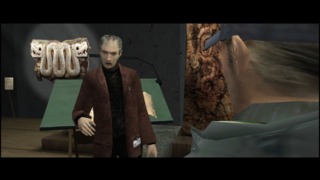
Kuriakin explains that Quechnitlan was a two-headed snake god in the Mayan religion. According to him, Mayans would make human sacrifices to the deity so that they could see into the afterlife. The sacrifice would be made by an "Oracle" who would pick an "Executor" from the crowd. The Executor would then carve the twin snakes onto their body, disconnect their victim's heart, and kill themselves. Lucas tells Kuriakin he believes that the ritual is being conducted today and that he's a new Executor. Kuriakin concludes that one of the ancient Oracles still lives and helps Lucas escape from the museum through a side door where two cars attempt to run them down. Lucas pushes Kuriakin out of the path of one, and the professor dies on the asphalt while Lucas goes on to destroy the vehicles.
Subsequently, our hero awakes in an exotic rainforest where The Oracle appears to him as a Mayan chieftain. He informs Lucas that the reason that he has not committed suicide is that he contains "The Chroma" which allows him to partially resist The Oracle's control. The Chroma is the ancient life force which created the universe. The Oracle sicks a panther on the man, but Agatha saves him and explains that The Oracle and his clan are seeking a girl with a "pure soul", the Indigo Child, and that Lucas needs to get her to safety. Immediately after, Lucas sees The Oracle's associates admonishing him. The Oracle tells them that Agatha has her own Chroma and the clan speculates that Agatha is a foot soldier of a second clan, that she is seeking out the Indigo Child, and that she is manipulating Lucas.
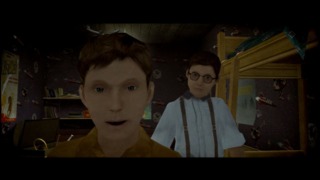
Now staying in a hotel room, Kane receives a phone call from The Oracle, telling him that he's kidnapped his ex-girlfriend, Tiffany, and is willing to murder her. To save her, this sallow superman visits the old funfair where he sees another familiar homeless gentleman, and the camera pays particular attention to a crow. He climbs to the top of a rickety rollercoaster, and despite Tiffany telling him the whole situation is a trap and that The Oracle is trying to kill him, he unties her. The Oracle shatters the rollercoaster from under them and Lucas blacks out, awakening to bright light and a mysterious voice remarking that everything's gone according to plan. He relives another experience from his childhood where he is shocked at what he finds inside one of the army's hangars, although we don't see the object ourselves.
As Lucas's life is splintering, Carla's inquiry into the source of the murders continues. She visits the Bellevue Asylum to interview Anton Janus, the killer in the Kirsten case. He displays that he already has knowledge of the laundrette murder, claiming to have a televisual link with its perpetrator. Carla can learn from him that it was a human sacrifice conducted by "The Orange Clan" so that they can take possession of a young girl. He describes The Orange Clan as an Illuminati-like organisation who run the world, can see what anyone is doing at any time, and that is vying for immortality. He predicts that humanity will perish in "the cold" and that a new race will rise in its place. Carla then visits Tiffany's grave where Lucas sneaks up on her. Lucas is pale and his skin as cold as ice, but he convinces Carla that he is not the murderer. The two exchange information about The Oracle, The Indigo Child, and The Orange Clan, and ally to oppose the cult.
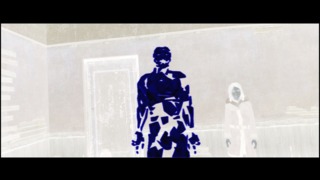
Carla retires to the police station where we learn over a radio that the temperature is plummeting worldwide and that Earth is grinding to a halt. Sam arrives at the station to tell Tyler she's evacuating to Florida and asks him to come with her; it's up to the player whether he does or not, but either way, this is where both exit the story. As for Lucas, his abilities let him locate the Indigo Child at the St. Thomas's Orphanage. He nabs the girl from the building, who turns out to be the same one from his visions, with The Oracle following close behind. The two have a Matrix Revolutions-style battle on the roof before Lucas is flushed from it by police helicopters. He ducks into an apartment where he finds Agatha who asks him to hand over the child to prevent The Orange Clan from capturing her and ending the world. No matter our choice, she reveals herself to be an enemy of Lucas, transforming into a humanoid that appears to be made of yellow light. Agatha explains that Lucas did die from falling from the rollercoaster, trying to rescue Tiffany, but that she is part of a clandestine group that brought him back to life. She tries to kill Lucas, but as you'll have noticed by now, he's good at getting off of any antagonist's hook.
A group calling themselves "The Invisibles" subsequently shelter Lucas and Carla. The Invisibles is an ancient order who've served to shield the world from The Orange Clan over the centuries. They corroborate the story about this one-world government which runs every sector from the political to the financial. They have also recently become aware of a "Purple Clan", a faction of AI who gained sentience on the internet in the 1980s who wish to get a hold of the Indigo Child to become the new dominant species on the planet. Agatha is one of The Purple Clan. The Invisibles say that whoever brings The Indigo Child to The Chroma will have the answer to all questions in the universe, and thus, ultimate power over it, but that time is running out. The Indigo Child will soon die, and humanity will go extinct if she is not delivered to The Chroma before a "final countdown" elapses.

The Invisibles are aware that The Chroma fell to Earth from space and that the government was secretly studying it at a military base; the same one that Lucas grew up on. On the radio, Carla hears a reporter declare that the world is ending in the global cold snap, and she and Lucas make love in a cramped train car believing it's their last night on Earth. Lucas then falls asleep and has a dream in which he recalls overhearing his mother and father arguing at the military encampment when he was a child. The argument clarifies that The Chroma irradiated Lucas in the womb which we can infer was the origin of his powers. Lucas returns to the military base to fight The Oracle and The Purple Clan's light man for possession of the Indigo Child and thus control of the world. The game ends with the planet under the fist of The Orange Clan or Purple Clan or with humanity saved but Lucas carrying the burden of being a demigod.
If you're feeling confused right now, you're getting the authentic Fahrenheit experience. The game leaves you scratching your head because its storyline is preposterous, the script doesn't explain many bewildering events, its characters act out-of-character, and digesting the plot means memorising a small encyclopaedia of lore dumps in the third act. We're going to break down the issues with the writing point-by-point:
1. Stretching the Bounds of Believability
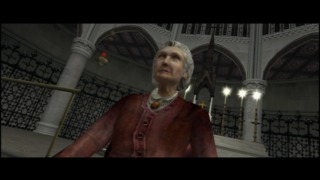
There is a fundamental contradiction between the grounded, relatable setting at the start of Fahrenheit and the conspiratorial make-believe realm it ends up in. Some audiences are more receptive to late introductions of supernatural elements than others, but Fahrenheit challenges even those with the most ironclad suspension of disbelief. Every time you think that you've gotten used to its idiosyncrasies, it introduces something even more laughable.
Its first few hours have scenes where we move the last of our ex's boxes out of our apartment and catch up with a friend over wine, but the culmination of the story involves Mayan wizards who are millennia old, and have become the Illuminati, carrying out mind-control murders so they can kidnap a magic autistic child before a group of evil AI who've been posing as a ghost do. At the same time, a superpowered undead I.T. manager is hounding them. About his off-the-wall game swarming with magic robots, David Cage said:
"I wanted to create an experience for adults with mature, realistic, believable topics".
2. Unexplained Mysteries
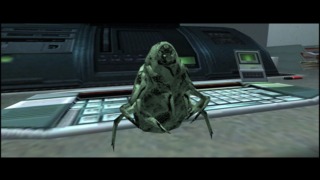
It's okay for a story to leave us with some unanswered questions. What's not okay is to introduce critical elements to your plot without explanations of what they are or how they got there unless you're exceptionally skilled at avant-garde storytelling. Fahrenheit is not exceptionally skilled at avant-garde storytelling. If the audience doesn't understand who or what a character or concept is, they won't know how it might affect the world or the humans in it, or what the stakes are. If they don't get a satisfying explanation for how it got there, then you're imposing an arbitrary logic on the story where the writer can make up what they want at any time, and there are no risks or consistencies. This is what Quantic Dream does. While many video game stories are guilty of deus ex machinas, reaching up their sleeves and pulling out the solutions to characters' struggles from nowhere, Fahrenheit does the opposite, making up new obstacles and stakes on-the-spot with no in-world justification.
What were the chittering insects which twice attacked Lucas in his workplace? If The Purple Clan planned to use Lucas to deliver the Indigo Child to them, why did they try to get him arrested for Agatha's murder? Why does Kuriakin die from being pushed over? How did primitive 80s computers give rise to consciousness, one of the most complex chemical processes in nature? How does a computer program transform into a ghost or a tangible being of light? How were The Purple Clan freezing the world to death? For all the time Fahrenheit dedicates to overfeeding you on background details, it never tells us who the primary antagonist is or what causes the big endgame threat to the characters. There's also the loose end of Anton Janus, the prophet from the asylum. Cage devises a clever way for his killer to conceal his crimes and deprive the detectives of interviews: The Oracle commits murders through a surrogate and then has that proxy kill themselves. But the script drops this rule for Anton; he doesn't end his life. And it does this because it wants someone to just tell our protagonist who the bad guys are at a point and there's no easy way for that to happen because The Oracle's modus operandi writes Cage into a corner.

The game does drop more clues about its ending than you might pick up on during a single playthrough. We kept seeing homeless people because they were The Invisibles monitoring Lucas, Kane saw crows around New York because the birds act as The Purple Clan's eyes and ears. Agatha withheld the identity of The Oracle, and in the church, told Lucas that none of the apparent clues meant anything because she was trying to throw him off the scent of the Purple and Orange Clans. The masks in Agatha's home were foreshadowing that she was not who she said she was; when Lucas wakes up from the rollercoaster collapse, and he hears a voice saying everything is going according to plan, it's a clue he's being manipulated; the council who interrogated The Oracle call the whole Agatha betrayal. Lucas's skin was cold because he was a corpse at the time. The lethal blizzard that overtakes New York and the reordering of humanity in the final battle were both predicted by Janus. The game drops a lot of clues elegantly, but at the time, these clues amount to telling us that Agatha is a turncoat and that homeless people are watching Lucas; they don't begin to let us untangle the madness behind the events up to that point. We spend hour after hour searching for and picking over evidence, and yet none of that evidence tells us what's going on, so it feels like a bit of a waste of time.
3. Out-of-Character Characters
Did you notice how the game has a whole sequence which drills into us that Carla has claustrophobia, but then on the penultimate day of the game she has sex and sleeps in an enclosed space without so much as light jitters? That's not intelligent writing, but at least it's not breaking anything plot-critical. The more foundational violations of the game's rules happen when Cage needs to get rational people to believe in irrational concepts. See, the problem he's created by having a down-to-earth narrative that turns into an impossible one is that now he has to get his down-to-earth characters to believe impossible things. But he can't do that smoothly and so has otherwise reasonable people be convinced, with a snap of the fingers, of ludicrous explanations for the murders.
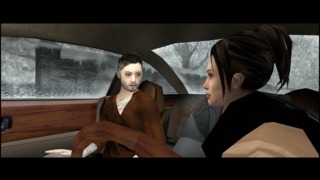
Carla is an accomplished detective who is capable of objectively and impartially assessing the facts of a case, but when Anton tells her about the existence of a world government watching every citizen at all times, she believes him without raising an eyebrow. The script signals to us that Janus is a reliable source of information because he knows about the violence in the laundromat, but just because he's aware of that crime, there's no reason for Carla to believe that anything else he says is true without hard evidence. But she does, and she does the same thing with Lucas, a suspected murderer. Then there's Dimitri Kuriakin, a literal professor of Mayan history, who jumps on board the conspiracy theory train the second that Lucas tells him Mayan magic is real. While Carla's inexplicable lack of rationality at least has plot utility, there's no reason for Cage to have written the conversation with Kuriakin like that. It's not as if he needs the professor to believe Lucas so that they can work together; Kuriakin dies seconds later.
4. Lore Dumps
"Lore dump" is a term invented to describe landslides of exposition that various "nerd culture" media have been prone to, but the storytelling sin at the core of a "lore dump" was recognised long before the phrase entered our lexicon. Where we're irritated by lore dumps, it's because they show, don't tell. If a writer explains the background for a story organically, then there's no reason for them to have a character rattle it off like they've got the wiki open in front of them. It's only necessary for the author to have that happen when they've failed to express the world history through events displayed directly to the viewer/reader/player. This means that lore dumps are not just grating in themselves but are usually indicative of underdeveloped exposition and world-building elsewhere in the text. And authors are told to "Show, not tell" not just because it's a more sophisticated form of relaying a story but also because when you use the full language of a medium to convey your plot, it has a more hard-hitting emotional impact on the audience and helps them remember it.
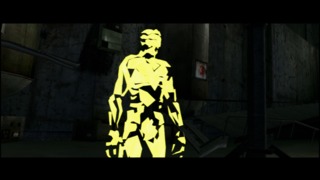
Fahrenheit comes across as this dumbfounding mush of pop mysticism because you have to memorise the contents of multiple expository monologues from the third act and it fails to reinforce the information in them elsewhere. It doesn't help that The Purple Clan and a few of the plot events are never adequately explained, making it unclear what information you've missed and what information doesn't exist in the game. Some crucial lore is also easy to accidentally skip past because it's hidden on a conversation branch you might never get to access. Remember, we can only pick a certain number of dialogue options in any one conversation and don't know what's going to come out of them. Additionally, the essential plot and lore reveals happening late on is a surefire sign of writing done wrong. When the previous seven hours of play haven't revealed what the relevant factions and conflicts of the world are then you start to wonder why we went through them at all.
And that's the most frustrating aspect. Fahrenheit has all these character dynamics and tribes who are the big players in its universe, but they never feel real or like they're relevant to most of the character drama because they live behind the scenes. We're told that there's a whole consortium of AI ready to overtake humanity as the dominant species, but we never witness them, only Agatha/the Light Monster. And we're told that The Orange Clan play with every character in this world like desk toys, but we only see a few hyper-specific examples of this manipulation.
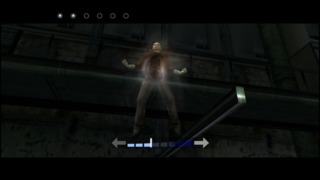
The game has the world end, but it might as well just have New York or this cast of characters destroyed; we never meet any people in the outside world or get a glimpse of the apparent armageddon, so what are we losing? In fact, when the news of it comes through to the characters, they don't bat an eyelid. The game tells you that there's this absolutely mind-blowing, world-changing stuff going on but it's just out of frame. It wants you to be rocked by its global scale drama, but it only has a local perspective. So not only does it ruin its believability with these incessant third act twists, it does it to introduce a story it has no intention of telling visually or mechanically. This is why it needs the plot dumps.
___
We're getting down to why it takes so many words to summarise the plot of Fahrenheit. I suspect that when he was writing it, Cage thought it was intricate, but really, it's just cluttered. Because much of the history of The Purple Clan and The Orange Clan and The Invisibles doesn't factor into the plot, you could trim that fat, reducing the number of eye-rolling exposition gluts. But I think I know why Fahrenheit believes they belong in there. Aesthetically, the game is inspired by Fight Club and The Matrix, and it wanted to have its moment when we thought we had followed all the evidence and knew exactly what the reality of our world was only to have us go through our red pill/Tyler Durden moment at the last second. But for the reasons listed above, it's not entertaining when Fahrenheit does it, and unlike the twists of those films, this game's twists feel shallow because they don't speak to real-world topics. Where Fight Club talked about toxic masculinity, and The Matrix talked more broadly about oppression and disinformation, Fahrenheit is talking about the non-existent issues of magic spells and the Illuminati. All this despite Cage describing how the game grapples so radically with adult topics.
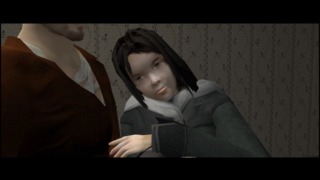
For more meaningless plot filler, refer to the moment where Tyler must decide whether he leaves New York with Sam. Whatever choice you make, it doesn't have any consequences because we never see either character again. Or note that The Invisibles simultaneously tell you that the planet is freezing and that The Indigo Child is dying. The world ending already imposes time pressure on the characters, so what's the narrative utility of also having The Indigo Child's days numbered?
And there are so many miscellaneous gaffs. On one of my playthroughs, the character models didn't load in during the sex scene, so the shots instead consisted of some fawning sweeps of a moaning mattress. Or there's the jarring cut from Carla and Tyler sparring backed by funky disco music to Lucas miserably stepping through the snow and placing roses on his child's grave. And we could say that "Fahrenheit is a product of its time" and wrap it all up with a neat little bow, but that wouldn't begin to cover it. In some lights, Fahrenheit is an age ahead of what was happening in video games in 2005, but from other angles, it's far behind its peers in fulfilling its mission statement.
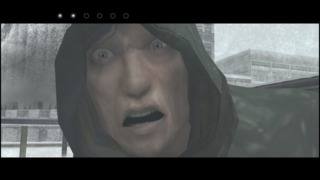
Its early preoccupation with everyday activities and a story that goes beyond the military, fantasy, or sci-fi brought the game a personability and relatability that was rare in 2005, as was its design which bravely gutted conventionally "fun" mechanics for systems mostly designed to put us better in touch with characters and their experiences. However, the majority of those systems don't succeed in connecting us to those characters or are used to play through the same kinds of sequences you might get in an action game, only with banal, mind-numbing coordination challenges. And while the medium's writing in the early 21st-century wasn't Pulitzer quality, it generally wasn't as unintentionally funny as what's going on in Fahrenheit. The stories were usually comprehensible even if they were as simple as "The aliens invade, you kill the aliens, you save the world". Fahrenheit is not only conspiratorial to an extreme that would make Dan Brown blush, but because it slides from being a more mature, advanced video game story into being the Ghost AI Illuminati thriller, it's hard to take as seriously as even the pulp action game narratives of its time.
To be fair, Cage has acknowledged in writing that the third act worldbuilding of Fahrenheit didn't work as a creative choice, and in an interview with Eurogamer, confessed that Quantic Dream didn't know what they were doing when developing it. But while many later Cage games will take lessons from the cautionary tale of Fahrenheit, we can also see how this game codifies some of their worst habits. Stilted, contrived, and emotionally blunted, Fahrenheit is everything that makes AAA game stories hard to recommend to your non-gaming friends. Thanks for reading.